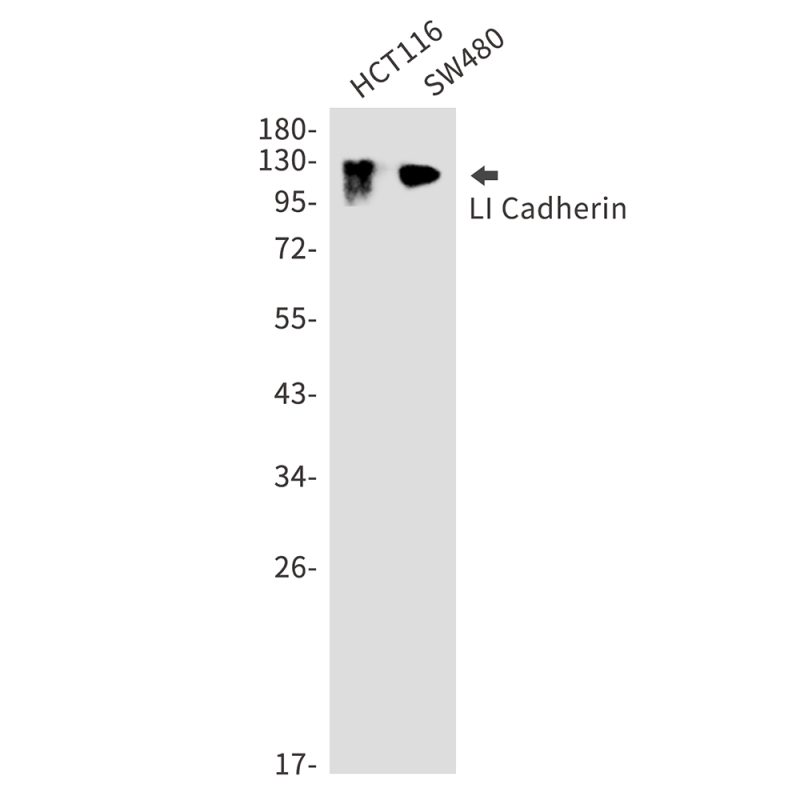
| WB | 1/500-1/1000 | Human,Mouse,Rat |
| IF | 1/20 | Human,Mouse,Rat |
| IHC | 1/50-1/100 | Human,Mouse,Rat |
| ICC | 技术咨询 | Human,Mouse,Rat |
| FCM | 咨询技术 | Human,Mouse,Rat |
| Elisa | 咨询技术 | Human,Mouse,Rat |
| Aliases | Cadherin 17; Cdh17; HPT 1; LI-cadherin; Liver Cadherin; liver inTine cadherin |
| Entrez GeneID | 1015 |
| WB Predicted band size | Calculated MW: 92 kDa; Observed MW: 120 kDa |
| Host/Isotype | Rabbit IgG |
| Antibody Type | Primary antibody |
| Storage | Store at 4°C short term. Aliquot and store at -20°C long term. Avoid freeze/thaw cycles. |
| Species Reactivity | Human |
| Immunogen | A synthetic peptide of human LI Cadherin |
| Formulation | Purified antibody in TBS with 0.05% sodium azide,0.05%BSA and 50% glycerol. |
+ +
以下是关于LI-Cadherin(CDH17)抗体的3篇参考文献及其摘要概括:
1. **"LI-cadherin in metastatic and non-metastatic gastric carcinoma"**
*作者:D. Berndorff等*
摘要:研究利用LI-Cadherin抗体分析其在胃癌组织中的表达,发现转移性胃癌中LI-Cadherin显著高表达,提示其可能作为肿瘤侵袭性的潜在标志物。
2. **"CDH17 is a downstream effector of HOXA13 in driving gastric cancer progression"**
*作者:L. Liu等*
摘要:通过LI-Cadherin抗体检测,揭示HOXA13转录因子通过上调CDH17表达促进胃癌细胞迁移和转移,为靶向治疗提供新思路。
3. **"Liver-intestine cadherin (LI-cadherin) enhances pancreatic carcinoma cell invasiveness through activation of the Erk pathway"**
*作者:M. Götze等*
摘要:实验显示,LI-Cadherin抗体阻断后可抑制胰腺癌细胞Erk信号通路活性,表明其在调控肿瘤细胞侵袭性中起关键作用。
4. **"LI-cadherin regulates intestinal barrier function via claudin-2"**
*作者:S. R. Barthel等*
摘要:利用抗体干预实验,发现LI-Cadherin通过调控紧密连接蛋白claudin-2影响肠道通透性,与炎症性肠病病理相关。
以上研究均通过LI-Cadherin抗体的实验应用,揭示了该蛋白在肿瘤进展、细胞信号及组织屏障中的功能。
LI Cadherin (Liver-Intestinal Cadherin), also known as CDH16 or cadherin-16. is a calcium-dependent cell adhesion molecule belonging to the cadherin superfamily. It is predominantly expressed in epithelial tissues of the liver and intestines, where it plays a critical role in maintaining tissue architecture by mediating cell-cell adhesion. Unlike classical cadherins, LI Cadherin lacks a cytoplasmic catenin-binding domain, suggesting unique regulatory mechanisms for its adhesion functions. Its expression is tightly linked to epithelial differentiation and polarity, making it a marker for studying tissue development and homeostasis.
Antibodies targeting LI Cadherin are essential tools for investigating its biological roles and distribution. These antibodies are widely used in techniques like immunohistochemistry (IHC), immunofluorescence (IF), and Western blotting to visualize LI Cadherin localization in tissue sections or detect its expression levels in cell lysates. Researchers employ these antibodies to explore LI Cadherin's involvement in physiological processes, such as epithelial barrier formation, and pathological conditions, including liver fibrosis, inflammatory bowel disease, and cancers. For instance, reduced LI Cadherin expression has been observed in hepatocellular carcinoma, highlighting its potential as a diagnostic or prognostic biomarker.
Commercial LI Cadherin antibodies are typically validated for specificity and sensitivity across species, particularly human and mouse. Their applications extend to developmental biology, cancer research, and studies of epithelial-mesenchymal transition (EMT), underscoring their versatility in both basic and translational research.
×